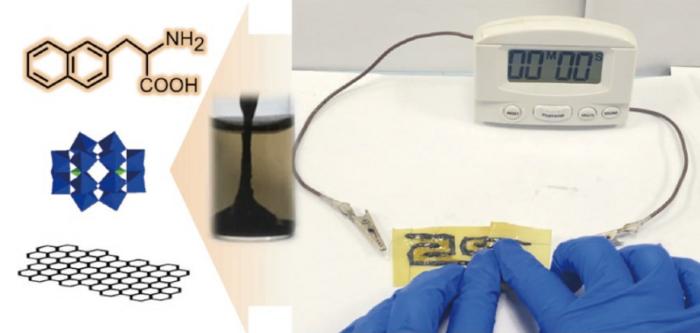Supercapacitors have the superb ability to capture and store energy. Researchers can use different materials and fabrication methods to make them flexible, thin and appropriate for use in wearable or implantable electronics, like smart watches or pacemakers, but those approaches tend to be intricate and costly. Now, however, a team from Jilin University in China has developed a kind of all-in-one adhesive electrode that solves one of the major issues facing advancing flexible 2D supercapacitors – making the components work synergistically.

Credit: Polyoxometalates, Tsinghua University Press
Supercapacitors have the superb ability to capture and store energy. Researchers can use different materials and fabrication methods to make them flexible, thin and appropriate for use in wearable or implantable electronics, like smart watches or pacemakers, but those approaches tend to be intricate and costly. Now, however, a team from Jilin University in China has developed a kind of all-in-one adhesive electrode that solves one of the major issues facing advancing flexible 2D supercapacitors – making the components work synergistically.
They published their findings on Mar. 29, 2024 in Polyoxometalates.
“Flexible 2D supercapacitors typically suffer from complicated and time-consuming fabrication procedures and poor mechanical endurance,” said corresponding author Wen Li, professor from Jilin University in China. “In this study, we created a new type of all-in-one adhesive electrode that can not only simplify the fabrication process but also overcome the interfacial displacement of conventional supercapacitors.”
Flexible 2D supercapacitors are typically sandwich stacked structure or 2D flat structure. Under repeated mechanical deformation, the interface between electrodes and the electrolyte can become displaced, rendering the interfacial contact less effective.
“However, the mismatched bulk strain between the electrode and the electrolyte layers usually causes the inevitable interfacial displacement and delamination during repeated mechanical deformation, giving rise to a significant increase in the interfacial contact resistance between electrodes and electrolyte layers,” Li said. “As a result, the charge/discharge rate is severely diminished and the energy storage performance as well as the stability are suppressed. More frustratingly, the integrated flexible supercapacitor devices in series for high-voltage output still depend on lots of conducting metal wires, which largely limit their flexibility, deformable tolerance and miniaturization for practical applications.”
To solve interfacial problems and eliminate wires, the researchers combined HPA with amino acids and carbon materials to construct a kind of all-in-one wet adhesive simultaneously carrying electron conduction, redox property, mechanical deformation, and adhesiveness. Heteropoly acids (HPAs), serving as a class of inorganic nano-sized clusters with fast and reversible redox activity enables the supercapacitor to quickly and reliably charge and discharge energy. The amino acids help the HPAs become more flexible, while the carbon materials contribute to electronic conduction. They patterned the resulting wet adhesive in a parallel manner to form flexible electrodes. After bridging the gap between the parallel electrodes by injecting a gel-electrolyte, they can conveniently create a flexible 2D supercapacitor.
“We found that the carbon components improved the electronic conduction; the chemistry of the amino acids contribute to the interfacial adhesion; and the HPA clusters both prevented larger structures from forming and endowed the electrode with electron transfer and storage ability,” Li said. “The resultant adhesives are adaptive and deformable materials that facilitate the development of flexible 2D supercapacitors for high voltage output with metal-free interconnects.”
The researchers said they would try to create substrate-independent and miniature flexible 2D supercapacitors for developing implantable power devices.
Other contributors are Chuanling Mu and Zhanglei Du, both students studied together with Li at Jilin University.
The National Natural Science Foundation of China and the Natural Science Foundation of Jilin Province supported this work.
About Polyoxometalates
Polyoxometalates is a peer-reviewed and interdisciplinary research journal that focuses on all aspects of polyoxometalates, featured in rapid review and fast publishing, sponsored by Tsinghua University, published by Tsinghua University Press and exclusively available via SciOpen. Submissions are solicited in all topical areas, ranging from basic aspects of the science of polyoxometalates to practical applications of such materials. Polyoxometalates offers readers an attractive mix of authoritative and comprehensive Reviews, original cutting-edge research in Communication and Full Paper formats, Comments, and Highlight.
About SciOpen
SciOpen is a professional open access resource for discovery of scientific and technical content published by the Tsinghua University Press and its publishing partners, providing the scholarly publishing community with innovative technology and market-leading capabilities. SciOpen provides end-to-end services across manuscript submission, peer review, content hosting, analytics, and identity management and expert advice to ensure each journal’s development by offering a range of options across all functions as Journal Layout, Production Services, Editorial Services, Marketing and Promotions, Online Functionality, etc. By digitalizing the publishing process, SciOpen widens the reach, deepens the impact, and accelerates the exchange of ideas.
Journal
Polyoxometalates
DOI
10.26599/POM.2024.9140062
Article Title
Taming of heteropoly acids into adhesive electrodes using amino acids for the development of flexible two-dimensional supercapacitors
Article Publication Date
29-Mar-2024




